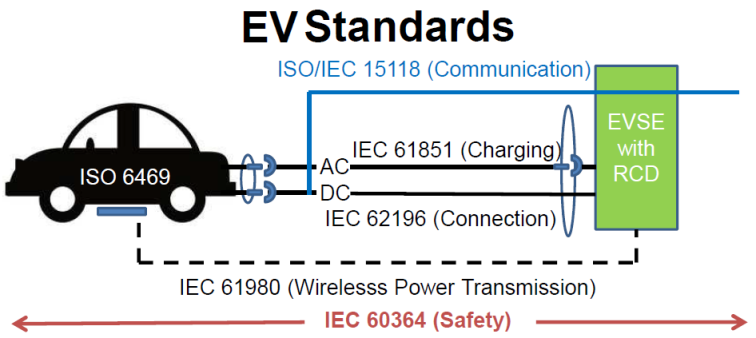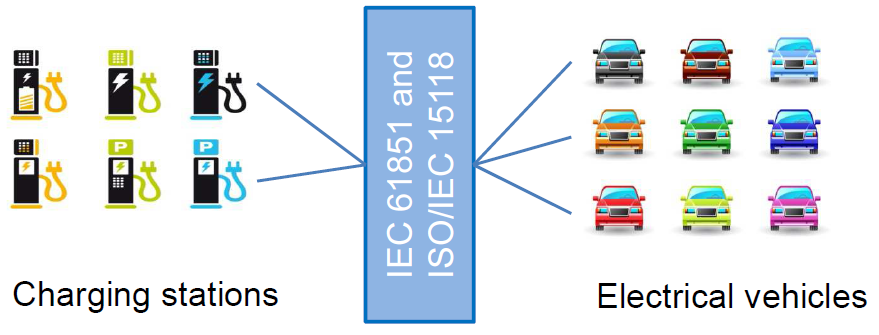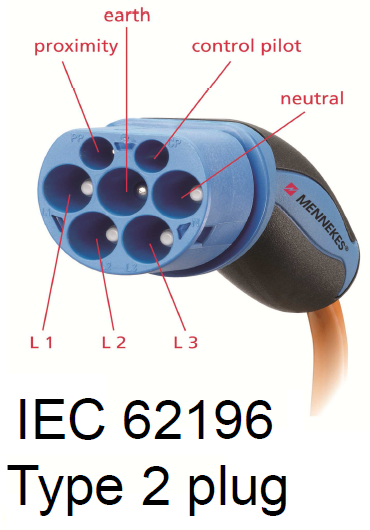2. June 2015 07:50 by Christian in
The battery capacity is essential in EV autonomy. Depending on the automotive OEM a fully charged EV battery can provide between 20 KWh (160 km for Nissan) and 85 KWh (480 Km for Tesla).
Charging Time / 100 Km
| Power Supply
| Voltage
| Max Current
|
6-8 hours
| Single phase - 3.3 kW
| 230 VAC
| 16 A
|
2-3 hours
| Three phase - 10 kW
| 400 VAC
| 16 A
|
3-4 hours
| Single phase - 7 kW
| 230 VAC
| 32 A
|
1-2 hours
| Three phase - 22 kW
| 400 VAC
| 32 A
|
20-30 minutes
| Three phase - 43 kW
| 400 VAC
| 63 A
|
20-30 minutes
| Direct current - 50 kW
| 400 - 500 VDC
| 100 - 125 A
|
10 minutes
| Direct current - 120 kW
| 300 - 500 VDC
| 300 - 350 A
|
Besides charging stations connected to the electrical grid based on fossil-fuel or nuclear power the industry is looking as well into renewable electricity for charging stations like:
- Solar Power Automotive Recharging Station
- E-Move Charging Station
- Wind Powered Charging Station
1. June 2015 19:52 by Christian in
Standards ensure the safety and reliability supporting government policies and legislation. Standards are opening up markets, ensuring interoperability, encouraging innovation and awareness of technical developments and initiatives.



EV_STD_RoadMap_1.pdf (657.24 kb)
1. June 2015 19:10 by Christian in
EV components responsible for electromagnetic emissions are the electric motor, the power converter, the power supply, and the lines/cables connecting them. The high speed switching device part of the power converter is the main source of EMI. The impedance of the electric motor that varies as a function of frequency is also an important factor in EMI analysis. Another EMI contributor is the behavior within the high frequency range of the traction battery providing power to the converter. The high-voltage bus (e.g. 900 V) connecting the power converter with the motor and the power supply must be kept very short to limit the emission of noise. The high-voltage system must be insulated and does not use the car body as return conductor like the low-voltage supply system does. The crosstalk between the different lines and the EMI radiated from the high-voltage cables into EV must be addressed.
31. May 2015 15:09 by Christian in
Mercedes-Benz developed new technologies to ensure the safety of driving:
- Helps the driver in guiding the vehicle in its lane and can follow the vehicle in front in slow-moving traffic automatically.
- Detects pedestrians and initiates autonomous braking to avoid a collision at speeds up to 50 km/h.
- Detects cross traffic and if required, boost the braking pressure applied by the driver accordingly.
- Adaptive High-beam Assist
- Active Blind Spot Assist
- Active Lane Keeping Assist
Cruise Control Steering Assistant to keep the car centered within the lane limits maintaining also the optimal distance to the vehicle ahead:
MB1.mp4 (24.85 mb)
Pre-Safe Brake with Pedestrian Recognition:
MB2.mp4 (22.69 mb)
Cross Traffic Assistant that enhances the braking system preventing collisions:
MB3.mp4 (20.55 mb)
Download and view MP4 files in VLC Media Player
31. May 2015 13:59 by Christian in
Norway is the champion of plug-in vehicle fleet per capita reaching in May 2015 over 50,000 pure EVs and about 4,000 plug-in hybrids using an infrastructure of 6,000 electric recharge stations. Norway government incentives succeeded to make the electric car purchase price competitive with ICE cars. Plug-in EVs are exempted from all non-recurring vehicle fees, 25% VAT on purchase, ferryboat fees, public parking fees, annual road tax, toll payments, and are allowed to use bus lanes.
In April 2015 YTD EV sales per country in Europe was 8646 in Norway, 5551 in France, and 3461 in Germany. The 2013 population was 5.084 million in Norway, 66.03 million in France, and 80.62 million in Germany.
In Mar 2015 plug-in EVs sold worldwide was 48,062 out of which 23,339 only in US.
In Apr 2015 plug-in EVs sold worldwide was 90,050 out of which 32,443 only in US. The US population in 2014 was 318.9 million.
US new public charging stations installed in the first quarter of 2015:
1. California: 436
2. Florida: 80
3. Georgia: 67
4. Washington: 52
5. Massachusetts: 50
6. North Carolina: 43
7. Texas: 40
8. Ohio: 37
9. Minnesota: 35
Excluding private stations in the United States the EV drivers have access to 9,639 electric stations and 24,784 charging outlets.